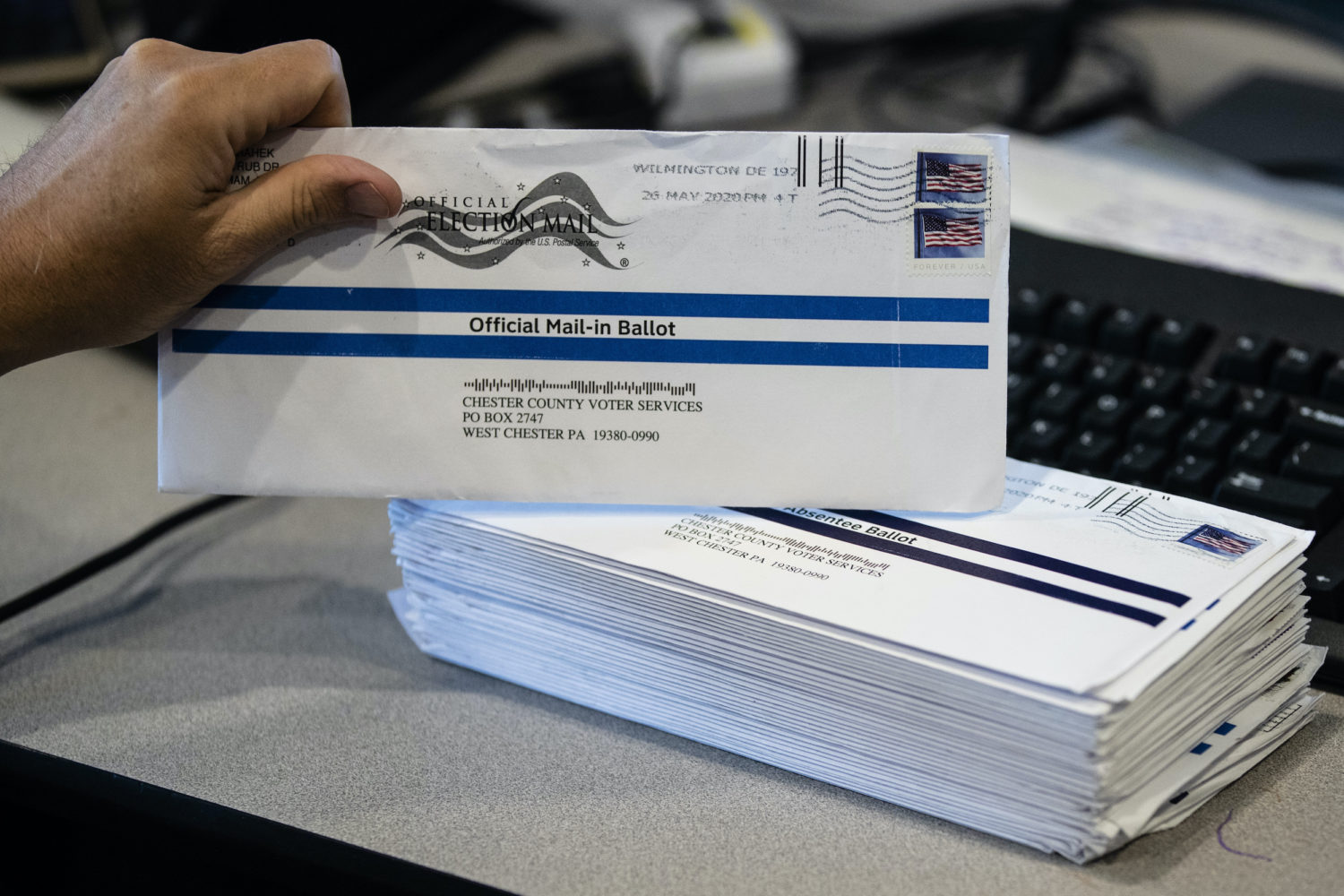If your time is short
- The expected increase in voting-by-mail in November is going to pose challenges for how election officials and journalists report the results, and how voters absorb them.
- Mail ballots usually take longer to count. This could lead to delays in declaring a winner in battleground states in the presidential race, possibly making “election night” more like “election week.”
- Experts are urging media outlets to continually explain these realities and maintain transparency about the vote count in order to head off conspiracy theories about the validity of the vote.
It’s time to let go of old ideas about how election night will work. This November, there’s a good chance we won’t have a clear winner in the wee hours of the morning.
Amid the coronavirus pandemic, many states are urging residents to vote by mail, and election officials are bracing for a more time-consuming ballot-counting process.
Ballots cast by mail require extra steps to verify a voter’s identity, such as comparing signatures, and require more mundane handling like opening envelopes and sorting. Their increased use makes it likelier that the candidate who leads early may fall behind once later votes are counted.
Election experts say that everyone — the candidates, the media, and voters watching the results roll in — needs to prepare for the possibility of delayed returns. There will be a lot more to come after Election Day, Nov. 3.
“It could easily be ‘election week’ rather than election day,” said John Lapinski, the director of elections at NBC News.
Here’s what you need to know, including some tips to help you keep your expectations in check after the polls close.
Why mail-in voting could transform election night
Consider this year’s California primary, in which 5.8 million people voted for president. Only 3 million of those ballots were counted by election night; the other 2.8 million votes took an additional seven weeks to count, said John Couvillon, a pollster and political analyst.
California is a virtual lock for Democratic nominee Joe Biden, so a delay in getting its final results won’t pose too much of an obstacle for calling the presidential race in November.
But several battleground states have eased rules for voting by mail this year, including Pennsylvania, Michigan, Wisconsin and New Hampshire. These are states without a lot of experience overseeing elections with high mail-in ballot participation. Other battleground states also expect to see increases in mail voting.
Collectively, this could produce delays and confusion, with media outlets unable to call enough states to give a presidential candidate at least 270 electoral votes on election night or even into the next morning.
The delays could be especially noticeable in states that accept ballots postmarked by Election Day but received afterward. Those states include the battleground state of North Carolina, as well as California and Texas.
The verification of provisional ballots, which often includes matching the affidavit signature on the outside of the return envelope against the voter’s signature on record, adds time. Not to mention the time it takes to simply remove ballots from envelopes and stack the ballots.
Election administrators have been pushing for laws that would allow them to start the verification process prior to election night. Many states allow this, as long as the ballots are not counted and the totals are not released until after the polls close.
Pennsylvania passed a law in March to allow clerks to start canvassing ballots at 7 a.m. on Election Day, rather than waiting until after the polls close. But some election officials have said that isn’t enough time. Pennsylvania Secretary of State Kathy Boockvar said she wants state lawmakers to change the law to allow officials to open ballots three weeks before Election Day. “That would help tremendously,” she told the Philadelphia Inquirer.
In Ohio, elections officials can start processing, but not tabulating, ballots about one month before Election Day. Ohio Secretary of State Frank LaRose said local officials are using creative contraptions — such as dumbbells with plywood — to flatten the ballots so they are less likely to get jammed when they go through the machines. “They all have some little trick,” he said.
In Arizona, a new election law will allow officials to start tallying results, but not posting them, 14 days before Election Day. In Michigan, a state Trump won in 2016 but that is in play for 2020, elections officials must wait until 7 a.m. on Election Day to start processing ballots. A pending bill could move that earlier by one day.
How long could it take to call a presidential winner? It depends
For historical perspective, in 2016, the Associated Press, a leader in election calling, declared that Donald Trump had won Pennsylvania at 1:35 a.m. Eastern time on Wednesday and that he had won Wisconsin about an hour later at 2:29 a.m. That was enough to put him over 270 electoral votes by early Wednesday morning, recalled Nathan Gonzales, the editor and publisher of Inside Elections.
It’s certainly possible that the 2020 voting could proceed on a similar track if the election turns out not to be especially tight. “If it’s not that close, we may be able to discern the presidential winner even if large shares of the vote are still outstanding in key states,” said Kyle Kondik, managing editor of Sabato’s Crystal Ball at the University of Virginia Center for Politics.
But Kondik and other election analysts are preparing for a drawn-out election, with threats of litigation potentially drawing out the process.
How to watch election returns in November 2020
If you’re someone who enjoys gathering around the TV with your family and friends on election night, there are a few things you should keep in mind before you settle in the night of Nov. 3:
Early leaders may not ultimately win. The candidate who has the lead early in the night may not win when all votes are counted, due to which ballots happen to be counted first.
In many cases, rural, more Republican areas with fewer ballots to count tend to be tallied first, while urban, more Democratic areas with heavier ballot loads are counted later. Sometimes, however, it goes the other way; in 2016, the earliest vote counts in North Carolina, Florida, and Ohio favored Hilary Clinton, but she ended up losing all three to Donald Trump.
These shifts are natural and aren’t “nefarious,” experts agree.
“It just means that different parts of states, with different political and demographic profiles, will be reporting at different points in the process, said Drew McCoy, the president of Decision Desk HQ, which reports election-related data to media outlets, political organizations, and private companies.
Beware of “percentage of precincts reporting” numbers. The metric has long been used in TV chyrons and online databases to indicate how much of the vote has been counted. But in an election conducted heavily by mail, the “precincts reporting” percentage is almost meaningless. The percentage of precincts counted may be close to 100% yet not take into account a large number of untallied mail ballots. Using the old metric could be highly misleading.
“We should never see a ‘100% of precincts reporting’ language again when there are thousands of absentee ballots yet to count and include in the totals,” said Rick Hasen, an election law expert at the University of California-Irvine.
Beware of political spinning. Early leads for one candidate can be hijacked by partisan commentators and then amplified on social media. For instance, more partisan-aligned media outlets may be comfortable “coloring in” the map quickly with the leads as they stand, regardless of whether or not the states have counted enough votes to justify a final call, said Edward B. Foley, an election law specialist at Ohio State University.
Widespread sharing of misleading maps on social media could “generate a narrative that one candidate already has prevailed when, in fact, there are lots of votes still left to count,” Foley said.
Allowing such claims to spread could damage public trust in the election if the other candidate is ultimately declared the winner, said a panel of election experts chaired by Hasen in a series of recommendations for ensuring public confidence in the 2020 elections.
“Political leaders should come together and speak out against candidates or groups who declare victory early or raise false claims about ballot tampering,” the report urged.
Be judicious about your news sources. Seek out political coverage that takes pains to explain the ballot-counting process to voters. For instance, trustworthy media sources will use the phrase “too early to call.”
Reliable media outlets will also make clear that slow counts or shifts in leads are not a sign of fraud or failed processes, and they will debunk viral misinformation, especially if it’s amplified by political figures.
Rick Klein, the political director at ABC News, said he is making these concerns a priority for his network’s election night coverage: “That’s a hard thing to explain to an audience. That part is keeping me up at night.”
Vote early if you can. Voters can help streamline the ballot-counting process by not waiting until the last minute to mail in their ballots, said Matthew Weil, director of the elections project at the Bipartisan Policy Center. “When I talk to voters I tell them to do it earlier in the process, so-called ‘flatten the curve’ of absentee voting so we don’t have to overwhelm the system,” he said.
Learning from California, Oregon and Washington
There may be lessons in the experiences of states that have become more accustomed to high levels of mail balloting and its resulting delays, such as Oregon and Washington state.
In Washington, voter irritation with long ballot counts has eased over time, said Russ Walker, the former assistant news director and online managing editor for KING-TV in Seattle.
“Over the years, most major news organizations arrived at best practices for explaining why some races aren’t called on election night,” Walker said. “The fact that there was so much reporting about the process every year, it resulted in a fairly consistent no-big-deal tone to coverage.”
Voters in Washington “are used to delays in knowing who wins close races,” added Jim Brunner, who covers politics for the Seattle Times. “It can be frustrating to wait, and I know partisan activists nationally may try to capitalize on shifting ballot results to raise suspicion about the process. But it’s just the way our system works.”
In Oregon, ballots must be received by Election Day, not just postmarked by then. “In more than 20 years we have had no serious questioning of results,” said David Sarasohn, a former political columnist with the Oregonian newspaper.
Ultimately, it comes down to doing more than just reporting the numbers, but putting them in context, experts say.
“It’s important for everyone who covers and works in elections to be constantly explaining to the electorate that results may be completed later this year than they usually are, and why that doesn’t necessarily mean something fishy is going on,” said Kondik of Sabato’s Crystal Ball. “In our conspiracy-driven political culture, that is a Herculean task, I’m afraid.”
Samantha Putterman contributed to this article, which was originally published on Sept. 8, 2020.









